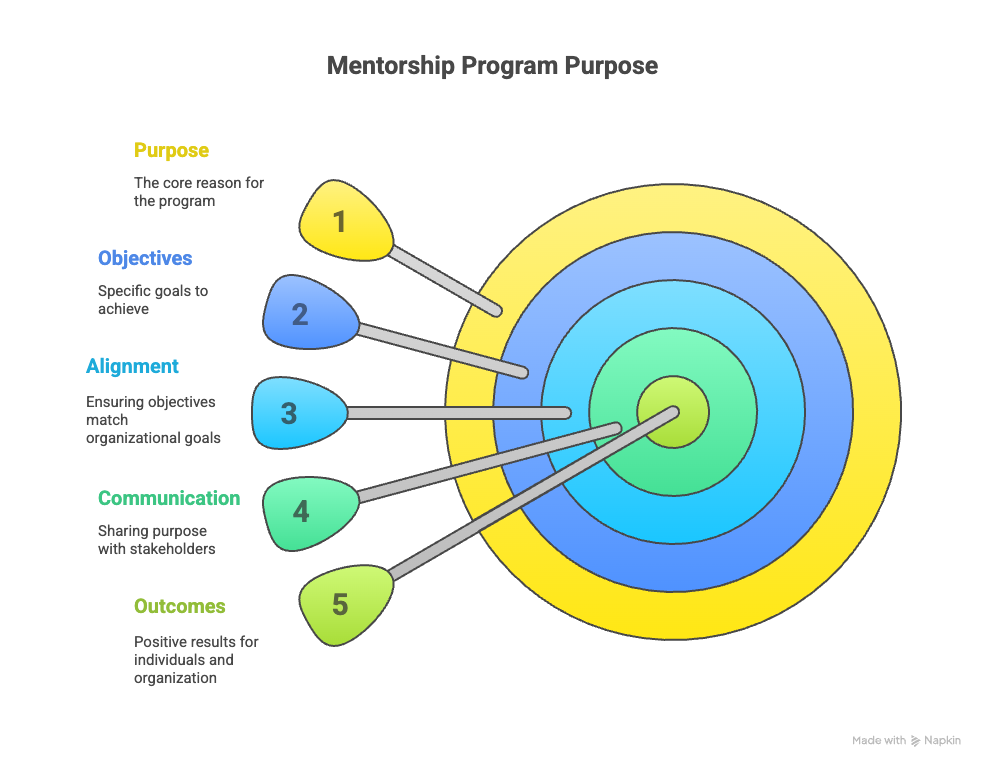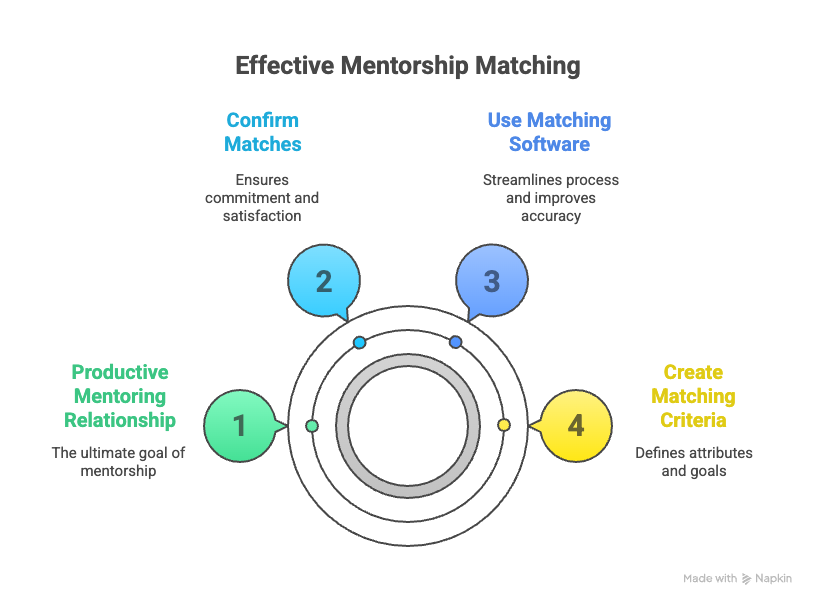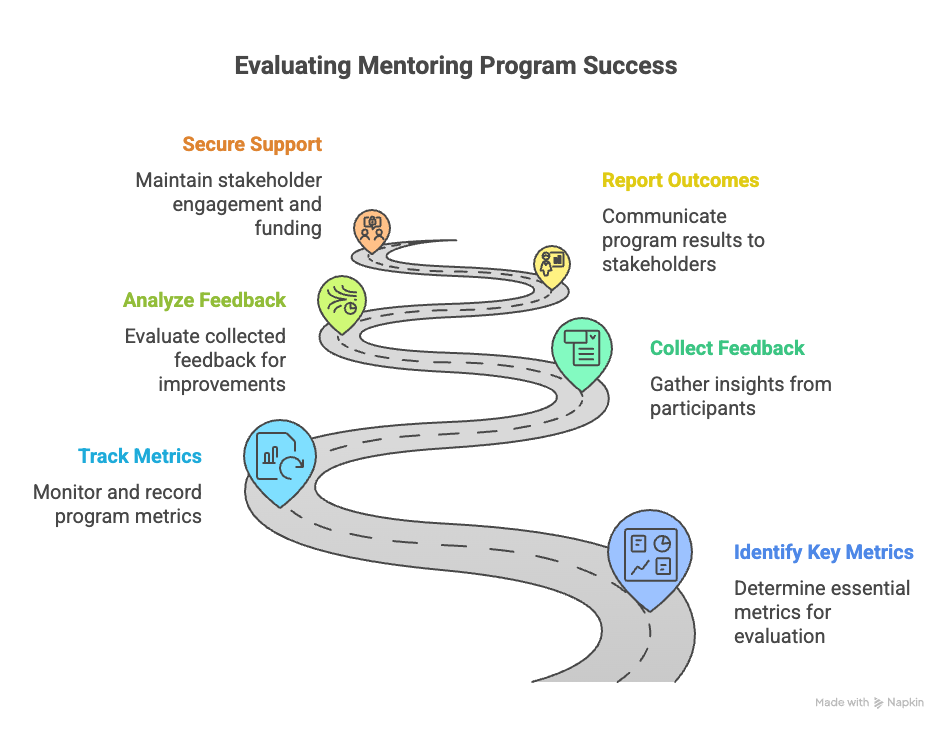How Do I Start a Mentoring Program: Top 7 Steps for Success
How do I start a mentoring program? This article covers essential steps like defining your program’s purpose, choosing the right type of mentoring, and recruiting participants. Follow these steps to set up a successful mentoring program.
Key Takeaways
- Define clear objectives using SMART criteria to guide the mentoring program’s purpose and alignment with organizational goals.
- Select and train mentors effectively while ensuring proper matching of mentors and mentees based on goals and interests.
- Continuously measure, evaluate, and adjust the mentoring program to ensure effectiveness and engagement from participants.
Define the Purpose of Your Mentoring Program

The purpose of your successful program mentorship program is the cornerstone of its success, setting the stage for everything that follows, from the mentoring model to success metrics.
Begin by defining your objectives. Identify key goals, align them with your organizational strategy, and document them in a way that resonates with stakeholders.
Identify Key Objectives
Clear learning objectives are essential for a successful mentor program. Use the SMART criteria to articulate goals:
- Specific
- Measurable
- Achievable
- Relevant
- Time-bound
Examples of goals include enhancing employee engagement and developing leadership skills capabilities.
Employees with mentors are more likely to stay with the company, thus reducing turnover rates and increasing overall employee retention rates.
Align with Organizational Goals
Aligning your mentorship program with enterprise organizations’ organizational goals ensures it supports professional growth and advances the company’s strategic objectives through a structured initiative that fosters career growth and professional development, including a company training program organized by program organizers.
For instance, increasing employee engagement and employee satisfaction are common goals that can lead to positive outcomes for both individuals and the organization.
Document and Communicate Purpose
Documenting and communicating the purpose of your mentorship program ensures accountability and clarity. Use clear, jargon-free language for all stakeholders.
This documentation will serve as a guide for both mentors and mentees, helping them understand the program’s goals and their roles in achieving them.
Choose the Right Type of Mentoring Program

The right type of mentoring program is crucial for meeting your objectives. Consider formats like One-on-One Mentoring, Group Mentoring, and Reverse Mentoring, each with its own benefits suitable for different needs.
One-on-One Mentoring
One-on-one mentoring, the most traditional form, involves:
- A more experienced individual guiding a less experienced person.
- Personalized career development through regular, in-depth discussions.
- Typically lasting over nine to twelve months.
Group Mentoring
Group mentoring involves one mentor leading a small group of mentees. This format is efficient for leveraging limited mentor resources, as it allows one mentor to guide multiple mentees simultaneously.
It also fosters a collaborative learning environment where mentees can learn from each other.
Reverse Mentoring
Reverse mentoring flips the traditional model on its head by having junior employees mentor senior staff members. This approach provides senior employees with fresh perspectives and helps them learn new skills, such as technology or current market trends, that they might not be familiar with.
Recruit and Train Participants

Recruiting and training participants are critical steps for a successful mentoring program in talent development. Effective recruitment strategies and comprehensive training can significantly enhance the mentoring experience for all involved.
Promote the Program
Promoting the mentoring program attracts suitable participants. Use the following strategies:
- Use internal communications and promotional materials to highlight benefits.
- Engage leaders and managers as champions to recruit and encourage participation.
- Ensure potential mentors and mentees see the advantages of the program.
Select Suitable Mentors for your Mentoring Program
Selecting suitable mentors involves assessing their skills, experience, and commitment. Key factors include their expertise, goals, and willingness to invest time in the mentoring process.
Ensuring that mentors are well-equipped to provide guidance is crucial for the success of unsuccessful mentoring programs.
Provide Mentor Training
Comprehensive mentor training equips mentors with necessary skills for effective mentorship. Training should cover communication skills, goal setting, and giving constructive feedback.
Interactive components like quizzes and group seminars can enhance learning and prepare mentors for their roles.
Match Mentors and Mentees
Effective matching of mentors and mentees is vital for a productive mentoring relationship. Consider factors such as career goals, skills, and personal interests to ensure compatibility.
Create Matching Criteria
Creating matching criteria involves defining attributes and goals that guide the process, including career goals, technical skills, and career direction.
Utilizing technology can also streamline the matching process and improve accuracy.
Use Matching Software
Mentoring software can significantly enhance the matching process by analyzing participant data based on predefined criteria. Customizable software allows for tailored pairings that consider preferences and diversity, equity, and inclusion (DEI) criteria, ensuring a more effective mentorship program.
Confirm Matches
Confirming matches between matching mentors and mentees fosters strong mentor mentee relationships. Allowing mentees some autonomy in choosing their matching participants pairs mentors enhances commitment and satisfaction, increasing the likelihood of achieving desired outcomes.
Support and Guide Relationships

Supporting and guiding mentoring relationships maintains momentum and ensures productive outcomes. Set clear guidelines, provide necessary support resources, and monitor progress.
Establish Clear Guidelines
Clear guidelines for the mentoring relationship are crucial. This includes setting expectations for regular future meetings and feedback sessions to prevent misunderstandings and keep both parties focused on their goals.
Offer Resources and Tools
Offering resources and tools like discussion guides and session agendas enhances the mentoring experience. These materials help structure mentoring sessions and ensure focus on learning objectives, fostering a productive mentoring connections relationship.
Monitor Progress
Monitoring progress through regular check-ins and feedback tracking progress the program’s success by:
- Identifying issues early through frequent feedback
- Allowing for timely adjustments
- Ensuring mentoring relationships remain effective and aligned with program goals
Measure and Evaluate Your Mentoring Program Success

Measuring and evaluating your mentoring program’s success enables continuous improvement. This involves tracking key metrics, collecting feedback, and reporting outcomes to stakeholders.
Track Key Metrics
Tracking key metrics like participation rates, interaction frequency, and satisfaction scores assesses the program’s effectiveness. Regular monitoring and reporting articulate program’s effectiveness and identify areas for improvement.
Collect Feedback to improve your Mentoring Program
Collecting feedback from participants through:
- surveys
- focus groups
- interviews offers in-depth insights into their experiences. This program feedback is essential for continuous improvements and ensuring the program remains relevant and effective.
Report Outcomes
Reporting outcomes to stakeholders demonstrates the program’s impact. A clear system for monitoring and reporting metrics ensures consistent measurement of effectiveness and helps secure ongoing support.
Avoid Common Pitfalls with your Mentoring Program
Avoiding common pitfalls ensures the success of your mentoring program. This involves securing leadership buy-in, allocating adequate resources, and maintaining flexibility.
Ensure Leadership Buy-In
Securing leadership buy-in is critical for a mentorship program’s success. A compelling business case demonstrating the program’s potential impact and valuable investment can help garner support from senior leadership.
Allocate Adequate Resources
Allocating adequate resources ensures the program’s success. To achieve this:
- Clearly outline the required resources in your business case.
- Involve relevant departments, such as IT, to justify the investment.
- Ensure proper implementation.
Maintain Flexibility in your Mentoring Program
Maintaining flexibility within the mentorship program involves:
- Adapting to evolving participant needs
- Collecting regular feedback
- Providing ongoing support These steps ensure timely adjustments and continued goal alignment.
Summary
In summary, creating a successful mentoring program involves defining clear objectives, choosing the right type of mentoring, recruiting and training participants, matching mentors and mentees effectively, providing ongoing support, measuring success, and avoiding common pitfalls. By following these steps, you can create a mentorship program that fosters career development, enhances employee engagement, and drives organizational growth. Ready to start your mentoring journey? The rewards are well worth the effort.
Frequently Asked Questions
What are the key benefits of a mentoring program?
A mentoring program significantly boosts employee engagement and retention while fostering leadership skills and facilitating career development. Implementing such a program can create a more motivated and skilled workforce.
How do I choose the right type of mentoring program for my organization?
To choose the right mentoring program for your organization, assess your organization’s size, goals, and resources, as well as consider the benefits of one-on-one, group, or reverse mentoring formats. This tailored approach will enhance the effectiveness of your mentoring initiative.
How do I recruit participants for the mentoring program?
To effectively recruit participants for the mentoring program, utilize internal communications and promotional materials that emphasize the program’s benefits, while encouraging leaders and managers to champion involvement. This approach will help generate interest and boost participation.
What criteria should I use to match mentors and mentees?
To effectively match mentors and mentees, prioritize criteria like career goals, skills, interests, and overall compatibility. Utilizing mentoring software can further streamline and optimize this process.
How do I measure the success of the mentoring program?
To effectively measure the success of your mentoring program, track key metrics like participation rates, satisfaction scores, and career progression. Collect participant feedback and share the outcomes with stakeholders for a comprehensive evaluation.
